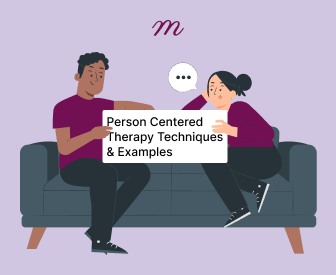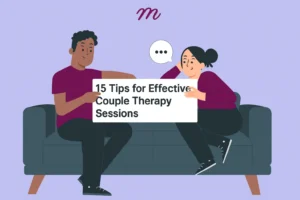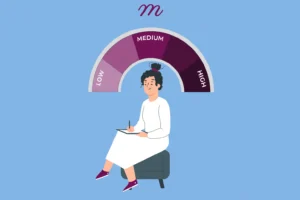Person-centered therapy (PCT) is a type of psychotherapy developed by Carl Rogers which focuses on creating safe and supportive environments where all individuals can explore their feelings. The emphasis of this approach is on the therapeutic relationship between clients and their therapists, who offer a source of understanding, acceptance and empathy. PCT is an empowering therapy approach as it helps individuals find solutions for themselves with facilitation from their therapist (Joseph, 2020).
It helps these individuals feel a sense of control and self-determination that helps them grow. Below we will review techniques of PCT and will follow Therapist Hillary and her client Maddie as an example to demonstrate how PCT can work in action.
Techniques and Examples of PCT
- Reflective Listening: This happens when a therapist actively listens to their client and repeats it back to them in their own words to demonstrate understanding. This is done to show the client that the therapist is hearing not just the words the client is sharing, but understanding the message and intended meaning as well. This helps clients feel heard and seen and builds trust with their therapist.
- Example: Therapist Hillary is working with a client named Maddie who is having a hard time balancing her work demands with her personal life. She feels overwhelmed and says things like “I just feel like I am drowning all the time.” Hillary hears this and offers empathy and understanding. She says to Hillary, “I hear you saying you’re feeling really overwhelmed and managing all the demands is feeling really heavy.” Maddie nods her head in agreement.
- Non-Directive Approach: This happens when the therapist just listens and doesn’t give specific feedback, directives or advice. The therapist helps the client by leading the client to go where they want to go. This gives clients the power in sessions to focus on what they want focus on and also empowers them to speak up and know that their therapist will support them and facilitate what they need. The therapist may rephrase or ask probing questions to help the client think through their thoughts.
- Example: Therapist Hillary continues to work with Maddie who goes on to share that it’s difficult to manage the schedules between work and her family. She feels like it’s hard to be there for everything and everyone all the time. Hillary listens and rephrases what Maddie said and asks her “When did it start to feel this way?” Maddie shares that it wasn’t so challenging when the kids were young because they were home and with their schedules now, they’re both in sports and the timing of everything is overwhelming and it’s her job to be there. Hillary listens and asks “How can you be there if you’re not physically able to be present?” Maddie shares that as long as one of her parents are there she feels good about it, but doesn’t know how to bring it up with her husband because she’s assumed the role for a long time.
- Open-Ended Questions: This happens when the therapist asks questions that require more than a yes or no answer. These questions get the client thinking and digging deeper than they may usually to get to roots of things. This helps because clients may not slow down enough in their daily life to reflect and this offers a safe space to reflect and consider deeper feelings which may have been neglected. This can happen simultaneously with non-directive approaches as well (Moddia et al., 2024).
- Example: Therapist Hillary continues on this conversation with Maddie and hears the stress in her voice. Maddie shares that she’s taken on the duties for the kids pretty much since birth as they were breast fed and her husband only had two weeks of paternity leave. She was a stay-at-home-mom for the first few years of their life and transitioning back into work has been challenging. Maddie is a lawyer and has certain time demands that sometimes conflict. Hillary asks “when did you first feel like you had to own it all?” This gets Hillary thinking beyond her becoming a mom. She recounts stories from high school and college when her parents were going through a separation and divorce. She was helping her little brother with school work and often picked him up after his soccer practice.
- Validation and Normalization: This happens when the therapist offers acknowledgement to the clients emotions and feelings they are sharing. The therapist makes sure to show acceptance and allowance for all the feelings that come up. They may even say that certain feelings are common or understanding based on the circumstances, which offers a sense of normalcy for the client.
- Example: Therapist Hillary here listens to Maddie recount her personal history of being in a caretaker role and not seeing a lot of male support in her life. Her mother took care of her. She took care of her little brother and now she is taking care of her children. Hillary says “It makes sense for you to feel like you have to do it all when you had a lot of responsibility placed on you when you were younger.” Hillary offers validation to her feelings and Maddie shares some more stories of what she did as a teenager.
- Silence and Space: This happens when the therapist will allow for silence in sessions to give the client some time to regroup and recenter themselves. It helps to give some space after a revelation so clients can process what came up and catch up emotionally (Ebrahimi et al, 2021).
- Example: Therapist Hillary listens to Maddie and after Maddie is done speaking, Hillary offers validation some more and Maddie goes a bit silent. Instead of trying to continue the conversation and fill the silence, Hillary mirrors Maddie’s more relaxed body language and sits with her in silence. Maddie takes a deep breath and looks up at Hillary and tears up a little. With the silence, Maddie was able to feel the feelings which were coming up. This helps both of them learn where they are now to know how to move forward.
- Focusing on the Here and Now: This happens when the therapist is able to help the client redirect back to the present moment and the present circumstance. By doing this, the therapist can help the client see how something from their past can still be at play today and that even if it feels like that today, the circumstances aren’t the same. This helps clients stay grounded in today and how far they have come and learn how their past experiences are influencing their emotions and decisions today. The goal is to try to stay present.
- Example: Therapist Hillary breaks the silence after a few minutes by asking Maddie what came up. Maddie shares that she was always the one to have to do it all and wanted to help, but it was a lot of pressure. Hillary asks Maddie if she still feels that she has to be the one to do it all. Maddie replies no, that her husband is very supportive. Hillary helps Maddie work through the competing feelings of having done it all and being burned out from still trying to do it all. Hillary asks what Maddie can do today that can be different. Maddie shares that she can talk to her husband about the schedule and plan it out to include him being more present. She shares that they both are used to her former schedule of being a stay at home mom so the timing wasn’t ever an issue. Hillary helps Maddie recognize that she has some tools and resources available to help her today in ways she may not have felt in her past, and that it is okay to ask for help and share the load.
PCT is centered around creating a safe space for clients to explore what comes up for them, on their terms. Clients tend to feel more valued and understood in this approach and can be used for any client. These techniques are a versatile way to get through to most clients and gives client a sense of mutuality and respect in being leaders in their own mental health care. By bringing the focus back on the current problems with empathy, clients are more likely to remember that old patterns don’t have to seep into the present and simply listening and supporting clients without judgment can go a long way.
References
Ebrahimi, Z., Patel, H., Wijk, H., Ekman, I., & Olaya-Contreras, P. (2021). A systematic review on implementation of person-centered care interventions for older people in out-of-hospital settings. Geriatric Nursing, 42(1), 213-224.
Joseph, S. (2020). Why we need a more humanistic positive organizational scholarship: Carl Rogers’ person-centered approach as a challenge to neoliberalism. The Humanistic Psychologist, 48(3), 271.
Moggia, D., Saxon, D., Lutz, W., Hardy, G. E., & Barkham, M. (2024). Applying precision methods to treatment selection for moderate/severe depression in person-centered experiential therapy or cognitive behavioral therapy. Psychotherapy Research, 34(8), 1035-1050.
Why other mental health professionals love Mentalyc

“If I were recommending this software to a colleague, I would tell them that it is the best thing that they could do for their practice.”
Licensed Professional Counselor

“Do yourself a favor, make your life easier. Use the tools that are readily available … I found Mentalyc to be one of the best tools that I’ve ever used.”
Licensed Marriage and Family Therapist

“For those who have hesitations … It is a lifesaver. It will change your life and you have more time to be present with your patients.”
Licensed Clinical Social Worker

“It immediately changed my quality of life, personally and professionally. I went from 3–4 hours a week of notes to 1 hour at most … that alone is invaluable personally and professionally.”
Owner/Independently Licensed Marriage & Family Therapist (IMFT)







